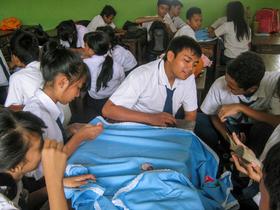For the 2025-26 school year, there is 1 public school serving 1 students in Clute, TX (there are 1 private school, serving 188 private students). 1% of all K-12 students in Clute, TX are educated in public schools (compared to the TX state average of 94%).
Clute, TX public schools have a diversity score of 0.00, which is less than the Texas public school average of 0.64.
Minority enrollment is 100% of the student body (majority Black), which is more than the Texas public school average of 75% (majority Hispanic).
Best Public Schools in Clute, TX (2025-26)
School
(Math and Reading Proficiency)
(Math and Reading Proficiency)
Location
Quick Facts
Rank: n/an/a
Brazos Harbor
Alternative School
1035 Dixie Dr
Clute, TX 77531
(979) 730-7340
Clute, TX 77531
(979) 730-7340
Gr: 6 | 1 student Student-teacher ratio: 1:1
Clute, Texas Public Schools (Closed)
School
Location
Quick Facts
Pineywood Community - Livingston (Closed 2023)
Charter School
1017 Us 59 Loop
Clute, TX 77531
(936) 634-5515
Clute, TX 77531
(936) 634-5515
Gr: 10-11 | 3 students Student-teacher ratio: 3:1 Minority enrollment: 33%
Frequently Asked Questions
How many public schools are located in Clute, TX?
1 public schools are located in Clute, TX.
What percentage of students in Clute go to public school?
1% of all K-12 students in Clute are educated in public schools (compared to the TX state average of 94%).
What is the racial composition of students in Clute?
Clute public schools minority enrollment is 100% of the student body (majority Black), which is more than the Texas public schools average of 75% (majority Hispanic).
Recent Articles

Charter Schools vs Public Schools 2025: Key Differences & Trends
Explore updated 2025 insights comparing charter schools vs public schools, enrollment, academic outcomes, funding, and real-world examples for families and educators.

Are Public Schools Ready for the 21st Century? 2025 Update
Explore 2025 insights on whether public schools are ready for the 21st century, covering performance, technology, equity, funding, and future-ready learning.

Public School Open House & Enrollment Season Guide
A parent-focused guide to the public school open house and enrollment season, with expert questions, timelines, and decision tips.
